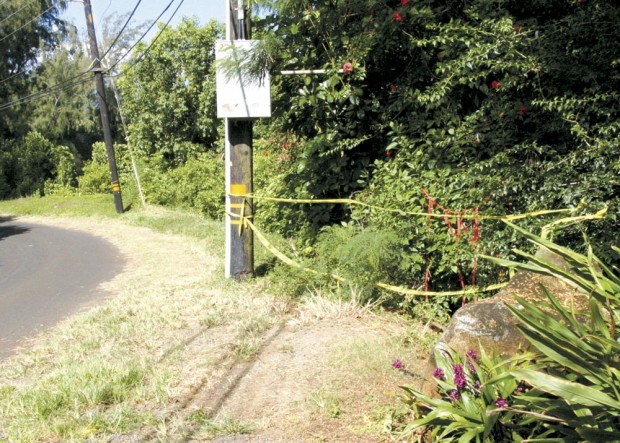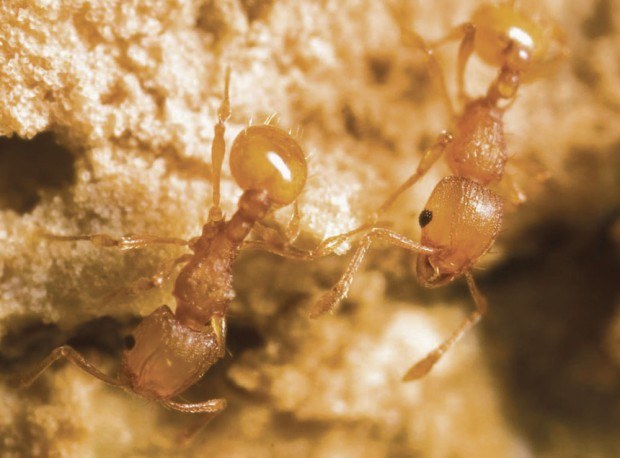Fight to eradicate little fire ants lasting more than 12 years
KALIHIWAI — It’s a kind of fire that does not cause smoke, but still burns pretty bad and the pain can last for weeks. It’s the sting from the little fire ant, a tiny and highly invasive species that has found a home on at least two properties above Kalihiwai Beach, on Kaua‘i’s North Shore.
Kris Newby, visiting from Palo Alto, Calif., was jogging last week on Kalihiwai Road when she saw a team from the Kaua‘i Invasive Species Committee deploying yellow caution tape near the driveway of a multi-million dollar property extending from the cliffs overlooking Kalihiwai Bay all the way to Secret Beach.
What Newby saw was just another battle in a 12-year-old war against the little fire ant, one of the smallest and nastiest invasive species on Kaua‘i.
“Little fire ants are notorious for swarming and biting when pets or humans invade their territory, which is typically five feet in diameter,” said Newby, a science writer for Stanford Medical School. “Their toxic, painful bites have been known to blind pets and send humans to the ER.”
Newby said a KISC worker told her that the ants — about 1/16-inch long, pale orange and slow moving — probably came over on plants brought in from the Big Island to the “ornately landscaped” property.
“He said it could take a number of treatments to eradicate the pest from the property,” Newby said.
The worker was right; KISC and the Hawai‘i Department of Agricultural have for many years waged a war against the little fire ants on Kaua‘i.
The first infestation of little fire ants in the state was found in 1999, in Puna, Big Island, prompting HDOA to enforce quarantine regulations to prevent spreading the pest to other islands, according to University of Hawai‘i’s College of Tropical Agriculture and Human Resources.
KISC stated in its 2007 Action Plan that the assumption is that the ants arrived on the Big Island on plants from a Florida nursery. Sometime later, a container of ornamental plants was shipped to Kaua‘i from Big Island to be used in landscaping a private property on Kalihiwai, on Kaua‘i’s North Shore.
When the HDOA found out the container came from an infested Big Island nursery, a survey was conducted on the property, identifying little fire ants on Kaua‘i for the first time. Staff from HDOA and the Hawai‘i Department of Health Vector Control Branch initiated eradication efforts by applying a hydramethylnon-based hydrazone insecticide, which goes by a trade name of Amdro.
Amdro, a delayed-toxicity food chain killer, is commonly used in the United States for fire ant control; the soldier ants carry the bait into the mount and feed it to the queen, killing her and the colony, according to Wikipedia. But the pesticide has its drawbacks: It cannot be used on food crops, the slow-working baits can take up to a month to be effective and it loses its effectiveness entirely if it rains or when the bait is moisturized, which could potentially bring a challenge in a wet place like Kaua‘i’s North Shore.
In 2003, KISC and HDOA staff returned to the same site and found out the infestation had spread to an adjacent property, according the Action Plan. Amdro was applied to roughly five acres on both properties. Since then, biannual surveys are conducted in the area.
‘Population is contained’
The Action Plan states it is “unsure about complete eradication” of little fire ants at Kalihiwai, but the ants have not spread beyond the area treated in 2004, and “it is believed that the population is contained and thus controlled from further spreading.”
A 2006 survey in over 56 sites on Kaua‘i, including nurseries, resorts and transfer stations, showed no little fire ants in other places on the island.
The KISC website states that there is one infestation known in the Kalihiwai area, under active control by KISC and HDOA.
KISC Project Coordinator Keren Gundersen declined comments.
There are no known little fire ant colonies on O‘ahu and Molokai. Maui was believed to be free of the invasive species until October 2009, when Maui News reported that the “much dreaded little fire ant” was found in a farm in Waihee.
Newby said the ecosystem of an island is very fragile, and the infestation is a good reminder of why inspectors do their job, which is so important.
County of Kaua‘i Real Property Tax records show that the property where KISC laid out caution tape is listed as belonging to Pali Nani LLC. The company is listed as a Kaua‘i business, but has the same Los Angeles, Calif. contact address as Hollywood actor Ben Stiller, according to a celebrity addresses website.
County records show Pali Nani LLC bought the 14.09-acre Kalihiwai property in 2002 for $8.5 million from Michael and Roxanne Klein, who in turn had bought the property in 1996 for $3.75 million.
The Garden Island attempted to contact Stiller’s publicist, Kelly Bush, to verify the actor’s ownership of the property, but the publicist was unavailable and did not respond by press time.
‘Satanica’
The little fire ant’s scientific name is Wasmannia auropunctata. It has different common names worldwide; but perhaps the ant’s most curious and fitting name is given in Cuba, where it is called “satanica.”
The little fire ant is considered by the Pacific Invasive Ant Key “the most dangerous threat to the Pacific Island Region.”
The ant is native to South America, but is rapidly spreading across many tropical regions, according to PIAkey.
“It is well documented as causing devastating damage to ecological and agricultural systems, and also poses significant human health risks,” states PIAkey, adding that the ant is considered to be one of the 100 worst invasive species in the world by the Invasive Species Specialist Group of the International Union for Conservation of Nature.
The ants infest agricultural fields, damaging crops and stinging workers, states the KISC website.
The stings produce large, painful, raised, red welts that can last for several days, aching painfully at first and later itching intensely in spells, according to CTAHR. The tiny ants are not quick to sting when handled, but will do so if trapped beneath clothing.
The KISC website states that the ants promote plant pests, such as aphids, white flies and scale insects, which secrete plant sap that the ants eat — the ants protect those insects from natural predators and parasites.
The little fire ants are not to be confused with the tropical fire ant, a stinging red ant that is two-to-three times longer, according to CTAHR.
Global impacts
The Global Invasive Species Database, managed by the ISSG of the IUCN has an extensive list of the ants’ impacts worldwide.
In Vanuatu, the little fire ant deters people from tending to crops, reducing productivity and imposing economic hardships. The ants sting even chickens. In Vanuatu’s Vanua Lava island, a lack of butterflies has been noted. Mota Lava island is free of little fire ants and has abundant butterflies.
In Wewak, Papua New Guinea, the ants over-run gardens and homes in residents’ houses and sting people, especially children. Control of insects within houses is expensive and many families may be forced to live with the ant.
In New Caledonia the ants have a negative impact on endemic ants, native spiders, beetles and reptiles.
In Guadalcanal, Solomon Islands, locals have reported that their dogs were all gradually blinded by the ants’ venom and rarely lived more than five years.
In French Polynesia, a progressive blindness syndrome has been documented in mammals and other animals that live in the proximity of colonies of the little fire ant.
In Gabon, house cats often have little fire ants in their fur, and several cats developed corneal clouding and blindness. Elephants with cloudy corneas are common in Petit Loango, as well as in Wonga Wongu. The ant also has a negative impact on Gabon’s native ants.
In Galapagos Islands, Ecuador, the little fire ant is considered probably the most aggressive species that has been introduced there. Marked reductions in scorpions, spiders, and native ant populations in areas infested with the little fire ant have been observed.
KISC reported on its website that little fire ants In the Galapagos eat tortoise hatchlings and attack the eyes of adult tortoises.
In Cauca River Valley, Colombia, the ants colonize agricultural areas, sometimes becoming an economic problem.
In Brazil the ants have been related to marked reductions of other ant species in agricultural lands.
In Queensland, Australia, several residents in infested areas were stung by ants whilst swimming in their pools. Dogs and cats have also been stung by the ants.
What to do
CTAHR asks residents to call HDOA office in Lihu‘e if an infestation is suspected.
“It is very important that you do not apply any toxic ant bait or spray at the site until the location is mapped and the ant is identified by HDOA,” states CTAHR. “Doing so will suppress the ants and make it more difficult to map them before control efforts started.”
CTAHR instructs residents to smear a thin coat of peanut butter on a chopstick end, and place it in a shaded area near a suspected infestation for about an hour.
Ants will be on the chopstick and, if they are orange or red and no bigger than 1/16 inch, put the chopstick in a zip-lock bag and place it overnight in the freezer.
Then drop off or mail the ants for identification to HDOA, Plant Pest Control Branch at 4398A Pua Loke St., Lihu‘e, HI 96766.



